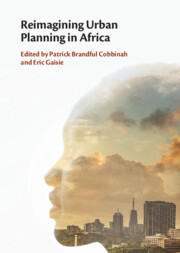Book contents
- Reimagining Urban Planning in Africa
- Reimagining Urban Planning in Africa
- Copyright page
- Contents
- Contributors
- Foreword
- Preface
- Acknowledgements
- Abbreviations
- Part I Understanding Sustainable Urban Planning in Africa
- Part II Case Studies on Urban Planning in African Countries
- Part III Sustainable Urban Planning in Africa
- 14 On the Need for Sustainable Digital Urban Infrastructure in Twenty-First-Century South African Cities
- 15 The South African Landownership Struggle
- 16 The 2030 Agenda, Climate Urbanism and Urban Planning in Zimbabwe
- 17 Urban Planning and Quality of Life of Urban Residents in Africa
- 18 Realising Rights in Complex Informal Settlements Contexts
- 19 Participatory Design Won’t Fix Unequal Southern African Cities
- 20 Enabling Smart Mobility in African Cities
- 21 On the Future of Urban Planning in Africa
- Index
- References
19 - Participatory Design Won’t Fix Unequal Southern African Cities
But We Should Still Do It, Just Better
from Part III - Sustainable Urban Planning in Africa
Published online by Cambridge University Press: 07 December 2023
- Reimagining Urban Planning in Africa
- Reimagining Urban Planning in Africa
- Copyright page
- Contents
- Contributors
- Foreword
- Preface
- Acknowledgements
- Abbreviations
- Part I Understanding Sustainable Urban Planning in Africa
- Part II Case Studies on Urban Planning in African Countries
- Part III Sustainable Urban Planning in Africa
- 14 On the Need for Sustainable Digital Urban Infrastructure in Twenty-First-Century South African Cities
- 15 The South African Landownership Struggle
- 16 The 2030 Agenda, Climate Urbanism and Urban Planning in Zimbabwe
- 17 Urban Planning and Quality of Life of Urban Residents in Africa
- 18 Realising Rights in Complex Informal Settlements Contexts
- 19 Participatory Design Won’t Fix Unequal Southern African Cities
- 20 Enabling Smart Mobility in African Cities
- 21 On the Future of Urban Planning in Africa
- Index
- References
Summary
Inclusionary spatial developmental practices regarding in situ upgrading of informal settlements in South Africa are widely recognised across disciplines as a crucial aspect in the redevelopment of South African cities. Under Goal 11, the SDGs explain in detail how such participatory principles are crucial to the sustainable development of all cities. Although the rhetoric around inclusionary development is well established, there remains considerable murkiness about what participative spatial development processes entail, what these practices look like in action, and where their value lies regarding the spatial implications of in situ upgrading in informal settlements. The chapter identifies and unpacks an identified ‘practice gap’ between the nature of participatory design processes and the reality of actioning such work, and argues for a more reflective and critically proactive approach. The study seeks to add to the growing discourse on practice-led knowledge towards reimaging practice frameworks across the sector of socio-technical spatial development for informal settlements. This is done through a careful blend of practice-based experience in South Africa with selected project partners. These reflections are then summarised towards supporting those working through the challenges of participatory spatial development processes in South Africa, and similar African contexts.
- Type
- Chapter
- Information
- Reimagining Urban Planning in Africa , pp. 345 - 371Publisher: Cambridge University PressPrint publication year: 2023



